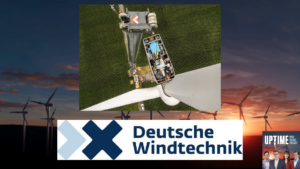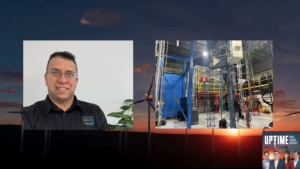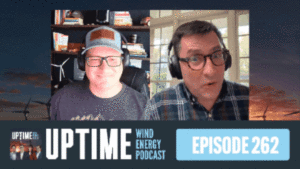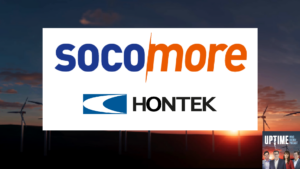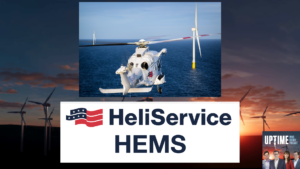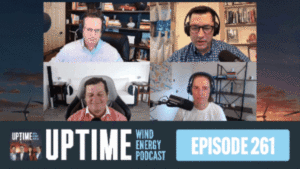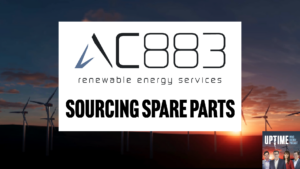Podcast: Play in new window | Download
Joel and Phil dive in to liquidated damages and how the industry can avoid big payouts. GE Vernova is dealing with another offshore blade failure in the UK, and our thoughts on the latest renewable energy Instagram craze. And, a discussion on a very full eagle! If you have encountered metal staples in a GE 2.X-116 or 127 blades, reach out to Joel at joel.saxum@wglightning.com.
There’s still time to register for AMI Event’s Wind Turbine Blade Conference in October 2-3rd! Click here – AMI Boston Wind Blade Conference
Need low-cost lightning strike sensors for your turbine? Email Joel at Joel.saxum@wglightning.com.
Sign up now for Uptime Tech News, our weekly email update on all things wind technology. This episode is sponsored by Weather Guard Lightning Tech. Learn more about Weather Guard’s StrikeTape Wind Turbine LPS retrofit. Follow the show on Facebook, YouTube, Twitter, Linkedin and visit Weather Guard on the web. And subscribe to Rosemary Barnes’ YouTube channel here. Have a question we can answer on the show? Email us!
Pardalote Consulting – https://www.pardaloteconsulting.com
Weather Guard Lightning Tech – www.weatherguardwind.com
Intelstor – https://www.intelstor.com
Allen Hall: All right. Really urgent news story here. A supposedly injured bald eagle. Now, remember that the bald eagle is America’s bird. Is it America’s bird or national animal? National mammal? And it’s also like the national symbol too. It’s a national symbol. There we go. All right. So a supposedly injured bald eagle, which is America’s national symbol.
Was rescued from a national park in Missouri and found it was acting like it was too injured to fly, but they took poor Eagle in and did an x ray on it and realized. That it was just full of raccoon. What? It was full? It had too much food? Yeah, it was found healthy, but engorged with raccoon. In other words, too fat to fly.
Philip Totaro: Is there tryptophan in raccoons?
Allen Hall: Oh, there may be.
Joel Saxum: I’ll tell you a fun fact about the eagle as the United States national symbol. Ben Franklin actually wanted it to be the turkey. And his reason. His reasoning was, eagles are actually scavengers and they eat dead things and turkeys don’t.
Allen Hall: Both of those birds are huge.
If you’ve ever been anywhere near a bald eagle, they are massive creatures. I, the thing that bothers me about this is that eagle was living large, relaxing, chilling, and then somebody grabbed him! Somebody scooped him up and with the x ray in him, the next thing he knows, it’s like he’s waking up in a hospital and all he wanted to do was watch the Cowboys game, I’m Allen Hall and I’ll be joined by the rest of the Uptime hosts after these news headlines. Denmark is making waves in the renewable energy sector with a massive 13 billion euro investment in offshore wind power. Aiming to boost capacity by 10 gigawatts across three areas. This ambitious plan, representing the largest tender for offshore wind power ever issued in Denmark, introduces a novel financing model where companies are required to make concession payments and co invest with the state.
Which will retain a 20 percent stake in each project. This initiative is expected to create thousands of jobs with estimates suggesting that each gigawatt of offshore wind power could generate around 9, 500. Direct and indirect positions and require a capital investment of approximately 2. 1 billion euros.
Beyond meeting national energy needs, the expanded capacity is set to position Denmark as a key exporter of electricity to neighboring countries. and a producer of green hydrogen. The European Commission’s wind power package is breathing new life into the continent’s wind industry with major players like Vestas and Siemens Energy expanding their operations.
Vestas is establishing a new nacelle and blade factory in Poland, potentially creating over 1, 700 direct jobs by 2026. While Siemens Energy plans to hire around 4, 000 new employees across Europe to bolster its grid equipment manufacturing capacity. To support this growth, the European Investment Bank has set up a 5 billion euro counter guarantee facility with the first tranche activated through a 500 million euro deal with Deutsche Bank.
Part of a larger portfolio expected to catalyze up to 8 billion euros in additional private investments. GE Vernova has encountered a series of setbacks in its offshore wind operations with the most recent being a turbine blade failure at the Dogger Bank Wind Farm off England’s northeast coast. This incident follows a similar blade failure at the same facility in May.
And another off the U. S. East Coast where a fallen blade has led to beach closures on Nantucket Island after debris washed ashore. Despite challenges, the global offshore wind sector is poised for remarkable growth, with capacity projected to surpass 520 gigawatts by 2040. Europe is expected to lead this expansion, hosting over 70 percent of global floating wind installations, while Asia aims to capture about 20 percent market share.
For The UK, Germany, and the Netherlands are particularly well positioned, leveraging their proximity to the North Sea and ambitious carbon neutral goals to potentially achieve a combined capacity of 150 gigawatts by 2040. In the United States, offshore wind development remains heavily influenced by the political climate, with capacity forecasts of up to 40 gigawatts by 2040 contingent on stable political support.
In technology advancements, SenseWind has successfully completed factory acceptance testing of its innovative 2 megawatt Sense self installing wind turbine system at Cali Ocean Systems facility in Glasgow, Scotland. The testing witnessed by ABL Group validated the lifting assembly designed to hoist the fully assembled turbine rotor nacelle up the tower, verifying crucial factors such as operational loads, bearing surfaces, repeatability, and contamination resistance.
This milestone marks a significant step forward in their demonstration program and builds confidence for the planned installation of a two megawatt wind turbine. Next year. And the Bureau of Ocean Energy Management is setting its sights on Hawaii for offshore wind development, planning a lease auction off Oahu’s coast for 2028 to support between 500 of wind energy.
The initiative aligns with Hawaii’s decarbonization targets and aims to reduce the state’s reliance on imported oil, biofuels, and hydrogen. This project, agreed upon by Akahi Energy and the U. S. Department of Defense, would utilize floating wind technology to navigate the deep waters surrounding Hawaii, with BOEM considering depths up to 1, 300 meters feasible.
That’s this week’s top news stories. After the break, I’ll be joined by my co host, CEO and founder of IntelStor, Phil Totaro, and the chief commercial officer of Weather Guard, Joel Saxum.
Lightning is an act of God, but lightning damage is not. Actually, it’s very predictable and very preventable. StrikeTape is a lightning protection system upgrade for wind turbines made by Weather Guard.
It dramatically improves the effectiveness of the factory LPS, so you can stop worrying about lightning damage. Visit weatherguardwind. com to learn more, read a case study, and schedule a call today.
Allen Hall: The AMI Events Wind Turbine Blades event in Boston is on October 2nd and 3rd. So it’s coming pretty soon.
If you haven’t booked your tickets to Boston, you better do it now. You won’t want to miss this conference. There’s big discussion on blade materials, blade design, blade manufacturing, and the supply chain. And with the recent high profile blade events, there will be plenty to discuss. So just Google AMI Events Wind Turbine Blades Boston, and it should take you to the proper page.
Also, the new low cost Eologix PING Lightning Sensor is available now. We are getting a lot of great feedback about the Lightning Sensor’s performance in the field. It has just a little integrated solar panel for power and uses local cellular network for data transfer, means No wiring to the turbine.
It’s just held on there by magnets. It’s truly incredible. Clean and simple, which is what everybody’s asking for. And if you want to purchase some lightning sensors for your turbines, you have to call Joel. And his number
Joel Saxum: is 832 593 2782. And so you guys know, they’re in shipment right now. We’ve got some of them heading out to an operator or two different operators.
As we speak, we’ve got confirmations today.
Allen Hall: Phil, what do they call that in the newspapers where they’re giving the corre is it corrections? Is that what they call that in the Wall Street Journal and the New York Times? Is there a corrections section of that newspaper?
Philip Totaro: Are they ever wrong, though, Allen?
Is that that is you’re correct. That’s what they call it, but do they ever really admit that they’re wrong?
Allen Hall: Occasionally. We’re not going to be like the New York Times. We’re going to be one better than the New York Times. We’re going to talk about the email that comes in here.
Some of it good and happy, some of it not so happy. So I think there’s one here that’s not so happy and has a point actually. So we’re going to be the first to correct this. This has to do with our discussion last week about Vestas or maybe two weeks ago now about Vestas in their Q2 reports. And how Vestas did sell a number of turbines and the order intake was pretty good, right?
And we got mired up in the discussion between Vestas building wind turbines and the Vestas development portion of their business and Vestas development is, as Bill has described it to me where they go out and put wind turbines in the field, which is unique for, I think, a lot of OEMs, like GE doesn’t do that.
Philip Totaro: Literally a project development division of the OEM company. Which, GAMESA used to do this, actually, GE did this with GE Financial Services, but they don’t do it anymore because, they still can get financing. The reason Vesta still does it is because there are some specific market opportunities they want to be able to pursue.
And so they have a pipeline of projects through the development company that is separate from the order book that is part of the OEM.
Allen Hall: So I conflated the two. Obviously, the order intake was up about 50% quarter on quarter to about 4 gigawatts, roughly. But the development side did not have a lot of activity.
And that was what I was trying to point out is that the development side wasn’t, didn’t have a really great quarter. And what that meant for the industry. Obviously, development is where the action is. You have to have development before you can have wind turbine. The commenter here, should I name, I guess I shouldn’t name them, but it’s a good comment and they’re right.
The second one is something we just actually discussed on the podcast and we weren’t sure about, which was this 3 percent metric that Vestas was discussing during their conference call with investors. Okay. This commenter points out that the 3% Is a loss production factor or, turbine availability.
So I assume that means 3% loss means 90% up. If it can be up a hundred percent, that would be great. But they want, 97% is still pretty good. They’re working on trying to get that number up to that 97% or 3% down, and that’s what Vest was just trying to convey in that conference call.
It was a little murky. Glad that someone actually wrote in and said, here’s what they meant. Here we go.
Joel Saxum: Phil, let me ask, can I ask you a question about this, maybe? Because I want to make sure that I’m proper here. When people talk about liquidated damages, can that be like, okay, so say your contract is, say you have a contract with your FSA that says 95 percent availability is what you’re going to give us.
If it’s 93 percent availability, does then the FSA holder have to pay the 2 percent in liquidated damages and production back to you, or how does that work?
Philip Totaro: Yes, so it’s a great question, and it boils down to what’s in the actual contract, so that can vary, but typically what happens is they’ll take The, either previous, few days average hourly production, or maybe they calculate monthly production, again, that’s going to depend on whatever’s in the contract but they basically calculate, like, how much electricity should we have produced and delivered, and we didn’t because of some technical fault or failure or whatever that, that occurred, and based on, That we should have delivered the annual energy production or, hourly annual or hourly production, I should say that they should have delivered multiplied by the power purchase contract price or if the, if it’s a merchant power contract, they have all the pricing information for, minute by minute.
What would we have gotten if we had delivered, X amount of power multiplied by that power purchase contract price. And that is essentially what they are obligated to deliver. Either in liquidated damages that they pay or they may have an insurance policy that covers a portion of those liquidated damages as well.
And that’s an insurance product that you can buy. It’s offered by, any number of different insurance brokers and underwriters. Visit your favorite broker to to discuss but, literally it’s, it is a situation where there’s any number of things that can actually trigger liquidated damages, faults and failures are obviously the most common but there’s any number of things that the FSA holder or O and M provider May have to be beholden for if something goes wrong and it’s not just a quote unquote active God or some other type of thing that, if they cause the lack of availability, they have to pay as effectively.
Joel Saxum: But that’s why in some respects people always want to point towards those first mature active God things like lightning damage or. I know icing is one, too, that sometimes people say hey, we, we can’t control this so that can be part of that wouldn’t, they wouldn’t have to pay with liquidated damages.
Philip Totaro: It’s, but it’s also interesting, Joel, because that’s one of those things where technically they may be right, that those are quote unquote acts of God, but, not for nothing, but I’m, I’ll give you a little plug here, but with Strike Tape, you probably wouldn’t have the lightning damage in the first place, or with, our friends over at Fabric Air, you might not have the icing issues in the first place, so it’s it is technically preventable, it requires, a little more capex up front to have these systems in place that preclude that from happening, but that’s also a huge, because, that’s the thing, Joel, this is a great question, because you’re gonna end up paying more, In liquidated damages, then what you are gonna end up having to pay to implement these solutions, definitely, Strike Tape, you guys might have to raise the price, but, it’s like, you could definitely deploy Strike Tape for cheaper than what you’re gonna pay one or two times in liquidated damages for having, turbines down because of
Joel Saxum: Yeah in my mind, and this is an argument, this is a not an argument, a conversation around the coffee.
Machine around the water cooler right this at some level. Is there negligence here, right? If you have a turbine that’s in Saskatchewan that doesn’t have an Arctic package and you end up having to deal with liquidated damages and stuff like you. That’s just ignorance.
Philip Totaro: Yeah.
It, negligence as a legal definition is, we’re not gonna get into that kind of a discussion today, but I, at the end of the day, you, I know where you’re going, but you’d have a hard time proving that from a legal perspective. It, the reality of it is that if people don’t get it by now. There is ample data, ample evidence to suggest that, spending a little extra upfront is going to save you in the long run.
And I’m not just talking about wind turbines. The same thing applies to your car or, doing predictive maintenance on anything is going to mean that you spend less having to repair that thing wholesale later when it just falls apart because you were too careless to actually.
Allen Hall: That’s interesting, Phil.
I haven’t thought about it that way. And I want everybody to think about something when we come back from the break, right? Because, Phil, I know you’re a big Instagram user. If you’ve been following all the traffic on Instagram from the wind turbine operators. I just have a, I have a grievance and I have to air this grievance and we’re going to do that right after the break.
Joel Saxum: As busy wind energy professionals, staying informed is crucial and let’s face it, difficult. That’s why the Uptime Podcast recommends PES Wind magazine. PES Wind offers a diverse range of in depth articles and expert insights that dive into the most pressing issues facing our energy future. Whether you’re an industry veteran or new to wind, PES Wind has the high quality content you need.
Don’t miss out. Visit PESWind. com today.
Allen Hall: If you haven’t visited BuildTurbines. com, you should do that. So if you’re interested in joining the wind energy revolution, and want to get a job in wind energy, you need some help, right? You need to understand what’s happening and all the variety of jobs and things you need to know.
And what kind of training you will need. And a simple place to do that is at BuildTurbines. com. Click the links. You can figure out, look at different options. If you need to go to school, all the schools are listed in the United States. It’s makes it real simple thing. It’s totally free. It’s totally free.
And it’s a service of Weather Guard. And on that vein if you haven’t seen some of the Instagram posts by some of the operators, I don’t want to name the operator specifically, but. There’s been one or two that have been posting a day in the life kind of videos on Instagram of an employee, typically an office worker the ones I’ve seen, I think I’ve been in Europe and maybe Joel, you want to describe what happens in these little vignettes?
Joel Saxum: What these videos are. And I’ve seen them across. It’s not just the wind industry doing this. A lot of places are doing it and it’s a way to, it’s a recruiting mechanism. It’s a way to show in the life of the company, it lift, as they would say in the UK, lifting the bonnet a little bit on what’s happening in the, in that world of that company.
But they’re starting off like, Oh, I show up at the office at 9. A. M. To me it’s crazy. I don’t think I don’t know the last time I ever showed up at work at 9 a. m But they follow them around the office and they show they’re working on this project meeting with these colleagues having lunch This that the other thing throughout the day and then heading home at the end of the day The particular one that Allen and I were talking about earlier shared some things that I think that if I was a, another employee of this company that wasn’t treated the same way or didn’t have the same perks of the job, I guess I would say I might be a little bit salty.
That’s just me.
Allen Hall: And the thing about the companies that post these videos or Instagram posts is that they have people who are doing really interesting things or very difficult things. And which is probably where they need people the most on the technician side and they haven’t posted a lot of pieces about those people because the ones I want to see is and a new employee with a chainsaw and a freaking blowtorch and they’re going out there and they’re making stuff happen right what you want to see let’s go
Philip Totaro: with a chainsaw and a blowtorch hang on hang on wait what are they doing with what are they doing with
Joel Saxum: that let’s go.
But Allen, to what you say is so I understand the concept of it, right? It’s an, it’s a marketing thing. There’s two sides of marketing and communications and PR. There’s internal and external. Most people, of course, only see external. Unless you work for a really large company, then you understand it.
There is an internal marketing team. There is an internal communications team. And the part of the goal there is, To show what the life is like. A lot of it is mostly on something like this is a recruiting tool. If you come and work for us, this is what your life looks like. However, to me, it comes off as tone deaf, right?
To me, it’s do you, should you really put this out there? I don’t know, it’s
Allen Hall: just. And the people we work with are not boring people. They’re not doing boring things like that, which is so weird.
Philip Totaro: Okay, so there’s, I think there’s maybe two issues. One is, joel, this is how the kids are doing it these days, so that’s a part of it.
Yeah, there you go. Secondly it’s also a way of storytelling. I think that’s really what the issue is. I don’t necessarily think, I didn’t see these because I’m actually not on Instagram, as Ellen has suggested. I wouldn’t even know how to sign up for it because, I’m getting up there too, but, It’s just it’s one of those things where, you know, the way in which you tell the story can have an impact on and Joel, it’s also morale, it’s like internal communications is also about maintaining morale, it is, as you said, about attracting talent.
And so it’s just, they may need some guidance because I, look, the bottom line is in the, I’ve been in the industry now about 17 going on almost 18 years and the reality of it is I’ve never actually seen Good marketing, if I can say it that way, like from anybody in this, when’s the last time, not to say that we have to take out like Superbowl commercials, but like when’s the last time you saw anybody do anything that wasn’t just advertising their products or services in industry trade publications or online or something like that. It’s we don’t really. Have the cream of the crop of marketing helping us tell the story that we need to be able to tell and frankly It’s a problem for the industry because that impacts our ability to attract talent and attract investment
Joel Saxum: I think what I would do phil is if I was a company within the wind industry I’d get on an amazing trend, and I’d probably start a podcast.
Or you could buy a podcast.
Philip Totaro: There may be one for sale. Or you could have a podcast that’s almost half a million YouTube subscribers. Such as the Uptime Wind Energy podcast.
Joel Saxum: I was thinking about this when we were talking about age just a second ago. To be honest with you, I think I have the most gray hair out of all of us.
That’s probably
Philip Totaro: true. I do spend a lot of time on the beach. Maybe a little pampered that way.
Allen Hall: If we want to talk about beach, maybe we should talk about the ongoing issues over at Vineyard Wind and we’ve been talking about it on slack behind the scenes. And I said, I don’t want to talk about it this week because I feel like.
We’ve talked about it a lot, however, and Phil brought up this point, it’s there’s been a lot of activity on some turbines at Vineyard Wind, and the only reason we know that is that there’s been photographers over there Monitoring what’s going on. And
Joel Saxum: well, there was a, I just saw this the other day, just watching the news, of course, because we’re sticking to those things right now.
But there was a, like a boat, not parade, but they called it a flotilla of protesters. Yeah, of angry protesters, like going out and fish on fishing boats and stuff out to vineyard wind. It’s getting pretty extreme over there.
Allen Hall: Yeah. And we have a man on the ground real close to that situation who said that the locals are restless.
Yeah. And yeah, you can. You can feel that happening. The one photo I thought was interesting, which came out, I think on Saturday or Sunday, a couple of days ago now was a of a technician, blade technician on the trailing edge of one of the vineyard blades and looked like there was an ultrasound piece of equipment there that they were doing some sort of scans along the trailing edge bond line.
That’s what it looked like to me. And If that is the bonding issue that, that LM is having in those blades, that’s a problem. Once your bond line starts to break, Phil, isn’t that just going to cascade into massive load problems?
Philip Totaro: Yeah, and we also have to mention this in the context of, there has now been yet another issue with a blade.
on the same turban model over at Dogger Bank again. So this is making three incidents that I, we still don’t really have any confirmation whether they’re all interrelated or not, whether this new Dogger Bank issue was actually a manufacturing issue or an installation error or what, but it’s painting a rather unfortunate picture at this point of The manufacturing, and probably more importantly, the quality control process that, that’s happening.
Whether that quality control process is even in the factory or just, when you’re doing a blade pick, you gotta check if the thing’s, in one piece before you put it up there, because if it’s not, Then you’re going to have these buckling issues and, whatever the root cause is, it’s bad for the company.
It’s bad for the industry. And, the folks at vineyard wind are going to point to all of these issues and say, why are we even doing offshore wind farms? And there goes your local community support for all
Joel Saxum: this. I think an advantage that they have at vineyard wind right now to solve this problem.
Is a lot of the blades are not installed yet. I think that wind farm is correct if I’m wrong out. I think it was 64 turbines total
Philip Totaro: 62 that were well, there were commissioned. They probably had blades on the other ones that when they stopped doing the blade installations after the. The failure,
Joel Saxum: but if the blades are in a lay down yard somewhere, at least they have the capability of they’re in there on stands in a lay down yard.
Hopefully they have the capabilities of doing some large scale N D. T. tests. I know these blades from talking with people in the industry have a lot of. Like a normal blade you look at has one shear web, and these have up to in certain locations, five different webs inside of them. So there’s a lot of bond lines to check here, and they have the advantage of the fact that these, a lot of these blades are probably, in lay down yards right now, and you’re able to do a large scale NDT campaign.
And then it hopefully at that stage, they figure out we get to an RCA, right? We haven’t heard what they’re really pointing at, but I would imagine that comes out sooner than later because there’s gonna be a lot of people looking at it. GE, of course, you’re gonna have they talk to Gulfwind Technology as an independent to come in.
I wouldn’t be surprised if you saw one of the certifications bodies sniffing around, and I’m sure insurance companies are going to have some experts on site, so there’s going to be a lot of people looking at it, some of probably the foremost blade experts in the world looking at these things, and we should hear of a conclusion, hopefully this quarter, I would hope.
Allen Hall: Yeah, I think they’re going to need it before they can get going again at Vineyard, and back to your comment, Joel, I believe Aarons is doing the internal blade inspections, looking from the information GE has released, that is an Aarons rover crawler, yeah, so they’re up inside these blades, and my guess is at least From the information we do have about Vineyard Wind, there’s a bond line deficiency, a lack of glue, or something didn’t bond up right there, so the putting a camera inside the blade is one way to do that, and obviously putting a technician on the outside to go look for bond line deficiencies is the other way to go do that, so they’re probably doing both.
That’s an educated guess at this point. But they got to get back up and running pretty soon. They’re gonna have to get RCA’s. Now they got two RCA’s to do, right? They have Vineyard plus Dogger Bank. It’s a lot of work on their plate.
Joel Saxum: The tough thing here, too, is and Allen and I, you and I have first hand experience of it from this week, an email from a client offshore, where they, North Sea right now, it’s been a really tough summer for weather, so they haven’t had, they haven’t been able to get out, even with to do these inspections, getting someone out on the transmission, transition piece up into the tower, out onto the blades, rope access, because that’s the only way you can do work offshore is rope access on blades, can’t throw a platform up there or something, it doesn’t work like that.
Yeah, So it’s tough to get access to these things. Now, the U. S. waters and watching the weather has been a little bit nicer, a little bit calmer, so they have a little bit better time getting access to these things, but offshore access is difficult. So that can extend the time frame as well.
Allen Hall: So after the break, I want to talk about another potential GE.
issue we came across this week that I need help from technicians in the field. And if they have some information, get ahold of us because we have a question. So after the break, let’s discuss that. Dealing with damaged blades, don’t let slower pairs keep your turbines down. Blade platforms get you back up and running fast.
Blade Platform’s truck mounted platforms reach up to 100 meters, allowing for a quick setup, improved safety, and efficient repairs. Book soon to secure your spot and experience a difference in blade access, speed, and efficiency. Visit BladePlatforms. com and get started today. All right, Joel. What are we talking about here?
We’ve been talking with some people that are out fixing GE2X blades, and they ran across something interesting while grinding.
Joel Saxum: Yeah, sparks. And as a blade technician working on composites you shouldn’t see sparks. That is not a thing that you want, unless you know that your grinder is gonna LPS cable or something, which it hopefully doesn’t.
But yes, someone doing repairs in the field and finding actual staples. In the blade, like in the blade layup. And I’m not, I don’t know the specifics about where exactly on the blade or how they came up across them, but they found staples in multiple blades on repairs they were doing.
And they found them by. The grinder throwing sparks
Allen Hall: and what started their investigation to go grind away at these blades.
Joel Saxum: They’re doing lightning repairs, right? These GE 2x machines. We, on the strike tape side, we’re looking at 2x machines all over the place. 116 meter rotors, 127 meter rotors. There’s nine or 10, 000 of them in the United States alone.
And a lot of them have lightning issues. Coincidentally, a lot of them are installed in basically the lightning alley, right up Texas, Oklahoma, Kansas. There’s a ton of them in the area up into Iowa. So there’s a lot of those machines out there and they have lightning issues. So this is lightning damage they’re digging into.
And of course, if you’re a blade technician or a blade engineer, or you even just seen some pictures have been around the industry, that when you’re repairing lightning damages, you’re A lot of times you see a pinhole or a little delamination or something and you gotta take the grinder to it to figure out how deep it goes and it can go very deep.
You can grind away the, part of the shell and you can end up into a repair the size of a truck hood. Pretty quickly. As they’re grinding away and scarfing into these things to do the proper repairs, as all of our great blade technicians do yeah, running into some staples in the composite layout.
Philip Totaro: And can we also clarify here, these are, industrial staples that were intentionally put in there to provide structural rigidity? Or some type of reinforcement? Or what would be the purpose of a company doing that? I
Joel Saxum: think it’s a small staple. That’s basically like in my mind, what I was having a conversation today, it was like someone with a hammer tack or like tacking fiberglass layup in place before they glued it down.
That’s my interpretation
Allen Hall: of it too. We, I have used plastic staples. If you get into some composite work I think you see this in boats a lot in some aerospace applications, but very specific, right? When you have a lot of layup material in these boats. Blades have a lot of material. Sometimes you want to bind them together to hold them together or try to keep them in place as you inject resin.
So you can put, generally speaking, these little plastic clips in to do that. But it sounds like there are some metal ones floating around. And I’m, that can’t be good for lightning. And so if you know something about that, if you’ve run across that, if your grinder has hit a metal staple on a GE blade, Reach out to us and you can get ahold of the podcast at uptime@wglightning.com.
Or you can just call Joel at (
Joel Saxum: 832) 593-2782 or send an email to, you can send it directly to me, joel.saxo, JEL do SAXU m@wglightning.com.
Allen Hall: That’s gonna do it for this week’s Uptime Wind Energy podcast. Thanks for listening, and please give us a five star rating on your podcast platform. And subscribe in the show notes below to Uptime Tech News, our weekly newsletter.
And you can find that same newsletter on Substack. Just look up Uptime Tech News on Substack. And check out Rosemary’s YouTube channel, Engineering with Rosie. And we’ll see you here next week on the Uptime Wind Energy Podcast.




